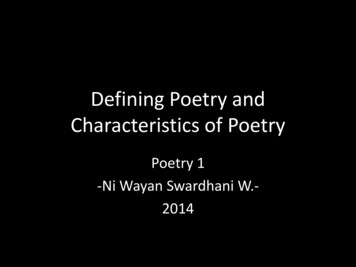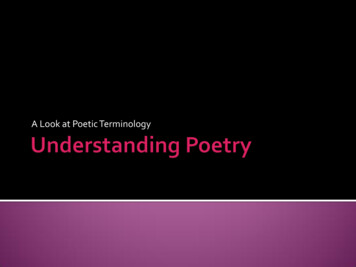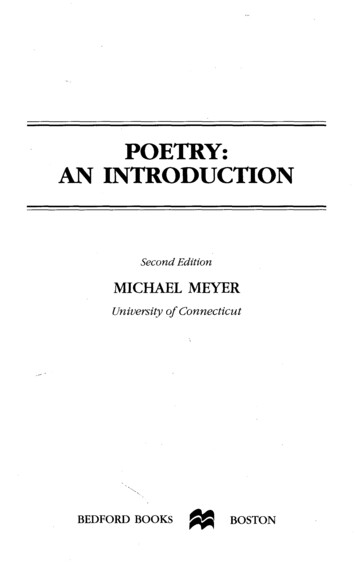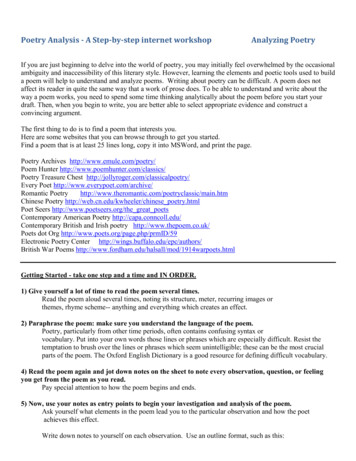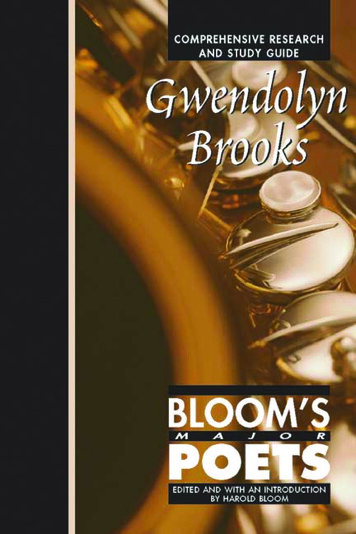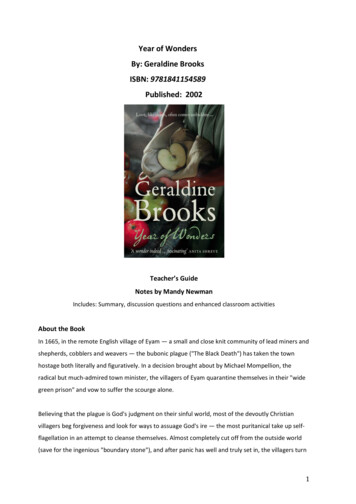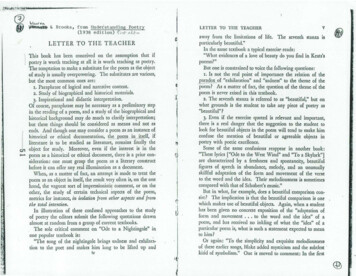
Transcription
ifll'. '.Hi(fUi'tlilli\J"'"" " & Brooks, from Understanding Poetry (1938 edition)f ;"l}- J, .LETTER TO THE TEACHERCiti-. This book h:ts been conccivecl on the assumption that ifpoetry is worth teaching at all it is worth teaching as poetry.The temptation to make a substitute for the poem as the objectof study is usually overpowering. The substitutes are various,but the most common ones arc:r. Paraphrase of logical and narrative content.2. Study of biographical ancl historical m:iterhils.3. Inspirational and didactic interpretation.Of course, paraphrase may be necessary as a preliminary stepin the reading of a poem, and a stu ly of the biographical anclhistoric:il background may .do much to clarify interpretation;but these things should be consic.lerecl as means ancl not asends. And though one may consider a poem as an instance ofhistorical or ethical documentation, the noem in itself, ifliterature is to be studied as literature, remains finally theobject for study. Moreover, even if the interest is in thepoem as a historical or ethical document, there is a prior con·sideration: one must grasp the poem as a literary constructbefore it can oiler any real illumination as a document.When, as a matter of fact, an attempt is made to treat thepoem as an object in itself, the result very often is, on the onehand, the vaguest sort of impressionislie comment, or on theother, the study of certain technical aspects of the poem,metrics for instance, in isolation from other aspects aTJd fromtlic total imcntion.In illustration of these confused approaches to the studyof poetry the editors submit the following quotalions drawnalmost at random from a group of current texlbooks. The sole critical comment on "O lc to a Nightingale" inone popular tcxlbook is:,"The song of Lhc nightingale brings sadness :rnd cxhil:ua·tion to the poet and makes him lung to be Hfte l up :m llvLETTER TO TUE 1'EACIIERvaway from the limitations of life. The seventh stanza isparticularly beautiful."In the same tcxlbook a typical exercisr. reads:"What evidences of a love of beauty do you find in Keats'spoems?"llut one is constrained to voice the following questions:1. Is not the real point of importance the relation of theparadoxof "exhilaration" and "sadness" to the theme of the.:--poem? As a matter of fact, the question of the theme of thepoem is never raised in this textbook.2. The seventh stanza is referred to as "beautiful," but onwhat grounds is the student to take any piece of poetry as"beautiful"?3. Even if the exercise quoted is relevant and important,there is a real danger that the suggestion to the student tolook for beautiful objects in the poem will tend to make himconfuse the mention of beautiful or agreeable objects inpoetry with poetic excellence.·Some of the same confusions renppcar in another book:"These lyrics ["Ode to the West Wind" an l "To a Skylark' ]arc characterized by a freshness an l spontaneity, beautifulfigures of speech in abundance, melody, and an unusuallyskillful adaptalion of the form and movement of the verseto the word and the idea. Their melodiousness is sometimescompared with that of Schubert s music."Uut in what, for example, docs a beautiful comparison con·sist? The implication is that the beautiful comparison is onewhich makes use of beautiful objects. Again, when a studenthas been given no concrete exposition of the "adaptation ofform and movement to the word and the idea" of apoem, :l!HI has received no inkling of what the "idea" of aparticular poem is, what is such a statement expected to meanto him?Or again: ccTo the simplicity and exquisite melodiousnessof these earlier songs, Blake added mysLicism and the subtlest ·kii{d of symbolism." One is moved to comment: In the first.'
'IIVI'LETTER TO TIIE TEACHERLETTER TO TIIE TEACIIERplace, the student can only be made to grasp the function ofsymbolism in poetry by the most careful investigation ofparticular instances; certainly, "the subtlest kind or symbolism"should not be flung at him with no fu rther introduction thanis provided by this sentence. In the second place, what canthe sentence mean on any level? Is it proper to say that anypoet "adds'' mysticism to anything? And what sort ofsimplicity is it to which subtle symbolism can be added? Docsthe melange remain simple? And what possible connectionis implied here between the "exquisite melodiousness" andthe mysticism and symbolism? In any case, the approachto poetry indicated in this sentence raises more problems thanit solves.To glean from another recent textbook: "Emily [Dickinson]the seer teases us into believing that she has dived into thedepths where great truths lie and has brought up new andastounding specimens. Many of her bulletins from Im·mortality seem oracular. Shorn of her matchless imagerythey turn out to be puritan platitudes or transcendental echoes.Her definitions of weighty abstractions arc tmphilosophical.They arc quick fancies, created out of a fleeting mood, an lme therefore frequently contradictory. But when Emilyfoilc l with logic, she succeeded with imagination." It isimpossible, apparently, to determine from what principles ofpoetic criticism these remarks can be derived. The objectionthat Emily Dickinson's poetry when "shorn o( its matchlessimngcry" would turn out to be platitudes could be raised withequal justification about the most celebrated passages ofShakespeare. The passage rests on a misconception of therelation of "trnth" to poetry, nnc.l on a confused notion of whatconstitutes poetic originality. Certainly, to clarify the issue of"truth" and poetic excellence, or of originality and poeticexcellence, woul l be a very ambitious undertaking; but thatfact scarcely justifies a complete fogging of the issue.Occasionally the writer of a textbook will attempt to deal yith poetry as a thing in itself worthy of study; and ap·fI''.Vllparcntly hoping to avoid the sort of vagueness foun l in thepreceding quotation, will isolate certain aspects of poetry forspecial investigation. In its crudest manifestation this im·pulse leads to statistical smvcys of one kind or another. Thestudent, for instance, is exhorted to count or to classi{y thefigures of speech in a poem; or to define metrical forms.There is a more sophisticated manifestation of the same im·pulse, ns for exnmplc, in the following classification of mctri·cal ellccts:"Some of the varied cffects produced by meter arc illustratedin the following stanzns:Sweet softnessSwiftly walk o'er the western wave,Spirit of Night!Out of thy misty eastern cave,Where all the long ancl lone daylight,Thou wovest dreams of joy ancl fear,Which m:ikcs thee terrible, nnd dcarSwift be thy flight!-Shelley, 'To Night'"Stark simplicityOut of the night that covers me,Black as the pit from pole to pole,I thank whatever gods may beFor my unconquerable soul.-Henley, 'Invictus'"The author has said flatly concerning these quotations thatthe eCTccts described arc "produced by meter." The statementis completely misleading and rests upon an imperfect under· .standing of the relation of meter to the other factors in a poem,A clever sllldcnt would immediately confute the author bypointing out that the line, "Out of thy misty eastern cave,"the meter of which is supposed to communicate "soft sweet·ncss," and the line, "Out of the night that covers me," themeter of which is supposed· to communicate "stark simplicity,"have exactly the same meter. In fact, he might point out thatm:p1y metrical cffccts arc common to selections which com·municntc very cliffcrcnt cmotionnl clTccts.
. W'J ,vmLETTER TO THE 'fEACIIERLETTER 1'0 'l'llll 1'EACHERThis ·is not to deny that meter is an important factor inpoetry, but it is to deny that a specific emotional effect canbe tied absolutely to a particular metrical instance. Theselections cite l lo produce different emotional crTccts, but thebasis for the effect c:m only be given accurately by a study ofthe relations existing among all the factors, of which meteris only one.Another instance of the isolation o( one technical fc:iturcwithout regard for the whole context and for the particularpoet's .method is the following observation in a recent textbook:"Hamlet's 'take arms against a sea of troubles' is a classicinstance of the poet's failure to visualize what he is saying.Longfellow's mariner, in 'A Psalm of Life' 'sailing o'er' life'ssolemn main' and at the same time apparently examining'footprints on the san ls of time,' is another example of con-Tomorrow an l tomorrow :tnd tomorrowCreeps in this petty pace from l:iy to l:iyTo the l:ist syllable. MacbethH the :1 :mi11:ttio 11Could trnmmcl up the consequence at l catchWith his surcease, success . Macbeth11'his matter of mixcJ mctnphor is discusml :it length on pp. 387-391.'i).W:is the hope drunkWhcrcm you drcsmJ yourself? hath it slept since?And wakes it now, to look so green and pale , , Macbethfosct! phrasing."This passage might be taken as a classic example of themisapplication of an undigcste l critical principle. We frequently sec in textbooks on poetry and in rhetorics the warn·ing :igainst the use of "mixed metaphor." llut, of course, inapplying this principle one must, in every case, examine· thecontext of the instance, the psychological basis, and the poet'sintcntion.1 These factors arc entirely ignored in the. presentquotation. For instance, the dramatic silu:ition in the passagefrom Hamlet and the rclalion of die slylc to it arc dismissed bythe high-hande l ancl abslr:ict applicntion of this principle. nci lcntally this method would eliminate the following wellknown passages, among many, from the work of Shakespeare:ixIThe. criti ii qucs i?n wou d npp:irendy be embarrassed bythe 1m:igmativc agility reqmrcd for rending much of Shake·spe re' , 1 oetry, especially the poetry of his so-called "greatperiod, simply bec:iuse he places his reliance on the mcchani·cal and legalistic application of a single principle withoutreference to context.As a matter of ironical fact, the image involved in thespeech quoted from am/et can be visualized. One has onlyto remember the stones of Xerxes, and Cuchulain1 one whopunished and one who fought the sea, to grasp the point.Furthermore, in justice to "The Psalm of Life," which is onenough counts a very bad poem, one can indicate that a littlemore :ittentive reading will reveal the foct that the marinerwho secs the footprints is not nctunlty on the high seas at themoment, but is, as the poem specifically says, a "shipwreckedbrother."The editors of the present book hold that a satisfactorym:th?d of teaching poetry should cmbo ly the followingpnnc1ples.1. Emphasis should be kept on the poem as a poem.2 . The treatment should be concrete and inductive.3· .A po;m should always. be trcatc l as an organic stem ofrelal1onsl11ps, and the poetic quality should never be under·stood as inhering in one or more factors taken in isolation:Vith the hope of giving these principles some vitality theeditors have undcrt:iken this book.This book must stand or fall by the analyus of indiviclu·alP?cms .which it contains. These analyses are intended to becl1scuss1ons of the poet's adaptation of his means to his ends·that is, discussions of the relations of the various aspects of poem to each other and to the total communication intended.10bviously, .the :i11:1lyscs presented in the early sections of thishook :ire s11nplc anrl very incomplete accounts of the prob·l,.j
x. i. I!jLETTER TO TllE TEACHERlcms involved. llut the analyses become more dillicult as the student is provided wilh more criLical apparatus and becomesmore acc'ustomcd to the method. The analyses, therefore,form pans of. an ascending scale and should not be studiedhaphazardly.The general organization of the book is, likewise, de·tcrminccl by this scale of ascending difficulty. The book hasseven divisions. Section I dents with poems in which thenarrative element is relatively important. Poems of thisgeneral nature appear here because the nar at ve interestseems to aflord the broadest and most unspec1al1ze(l :ippealto the ordinary student. The basic question behind the{lnalyscs in this section is: tuliat distingttishcJ tl1c poetic treat·ment of a story fram the more twrnl f'rosc treatment? Sec·tion II deals with poems in which the narrative is merelyimplied or is suppressed in favor of some such interest as thatin psychology or character. Section Ill takes up nother ap·proach, that of the poet as observer rather than as n:mat.or.The material in this section ranges from poems wluchostensibly arc simple, objective descriptions to the last poems,in which description emerges with a definite symbolic force.Section IV takes up one of the more specialized technicalproblems, that of the nature of rhythm and meter ns meansof communication. The analyses in this section naturallyemphasize the technical consiclcrations of verse, but the at·ter.npt is constantly made to indicate the relation of theseconsiderations to the others which the student has nlrcadystudied. In Section V arc considered some of the ways inwhich tone and attitude nrc communicated to the reader.The poems of Section VI present some special problems inthe use of imagery as a device of communication, and thoseof Section VII raise questions concerning the !unction of ·iclea and statement.Although the poems nrc arranged in these groups, it is notto be understood that the topics which determine the arrange·mcnt arc treated in isolation. As a matter of fact, the analysesiLlffTER TO THE 'l'EACilERI1·Iil·lIIl.I'.Xland questions which arc nppcnded to ench poem aim at mak ing the student aware of the Q!gnnic rclations!tlrr existingamong these factors in poetic communication. Obviously,:rny poem whatsoever would, finally, raise the questionsassociated with all of these topics. Questions involvingimagery, for example, occur even in Section I an l arc treatedin the analyses. Pedagogical convenience, however, demandsthat special atte
& Brooks, from Understanding Poetry (1938 edition) f ;"l}- J, . LETTER TO THE TEACHER This book h:ts been conccivecl on the assumption that if poetry is worth teaching at all it is worth teaching as poetry. The temptation to make a substitute for the poem as the object of study is usually overpowering. The substitutes are various, but the most common ones arc: r. Paraphrase of logical
